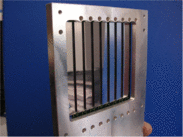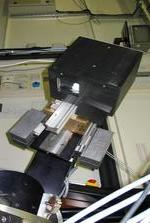 |
| Back |
XPIX | |
Development of imaging devices for X-rays in material science (collaboration between CPPM, ESRF/DAM and SOLEIL). The high flux and the high brightness of third generation X-ray synchrotrons were not followed by equivalent progresses in the detector field. | |
The technology of hybrid pixels developed for the ATLAS high energy physics experiment at LHC offers several key features that help to fill this gap. A hybrid pixel detector is made of a matrix of pixels in which each pixel is assembled by bump bonding to a dedicated electronic circuit. One obtains high counting rate, extremely high dynamic range, single photon counting, energy selection and fast readout. This makes their use very attractive for X-ray imaging experiments in Material Science (powder diffraction, crystallography of proteins, drug characterisation...). |  |
A family of hybrid pixel imagers tailored for crystallography experiments is under development at CPPM in collaboration with the DAM group (Diffraction and Abnormal Diffusion Multi-wavelengths) of the ESRF (Grenoble) and the detector group at the SOLEIL synchrotron facility in Saint-Aubin, close to Saclay. The detector part is either made of silicon or of Cd(Zn)Te. The electronics part is designed to ensure large dynamics for instantaneous (10-2 up to 108 photons/s/mm2) and integrated (1030 photons) light intensities and an image acquisition time of about a millisecond. | |